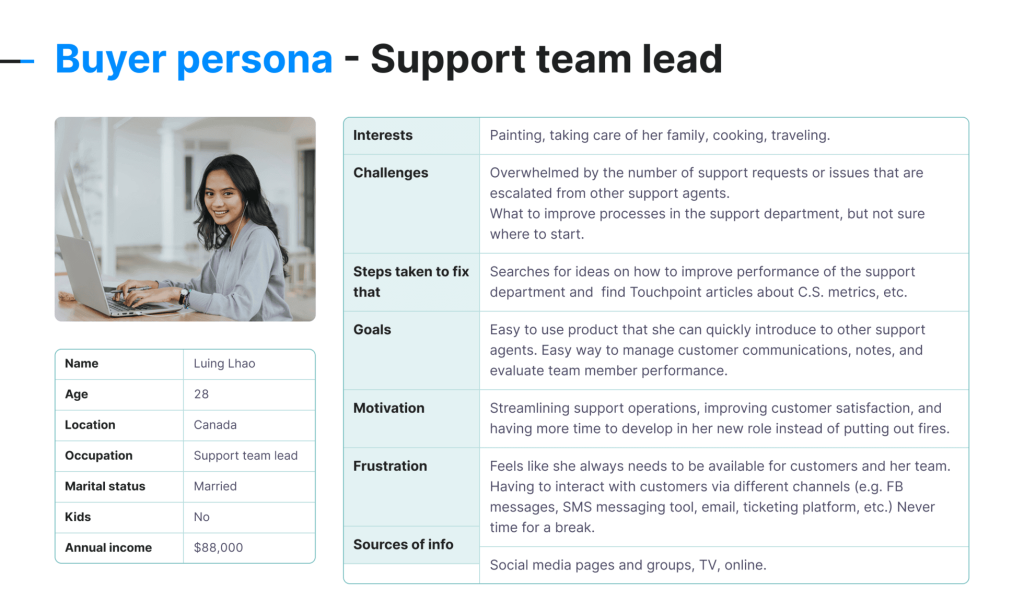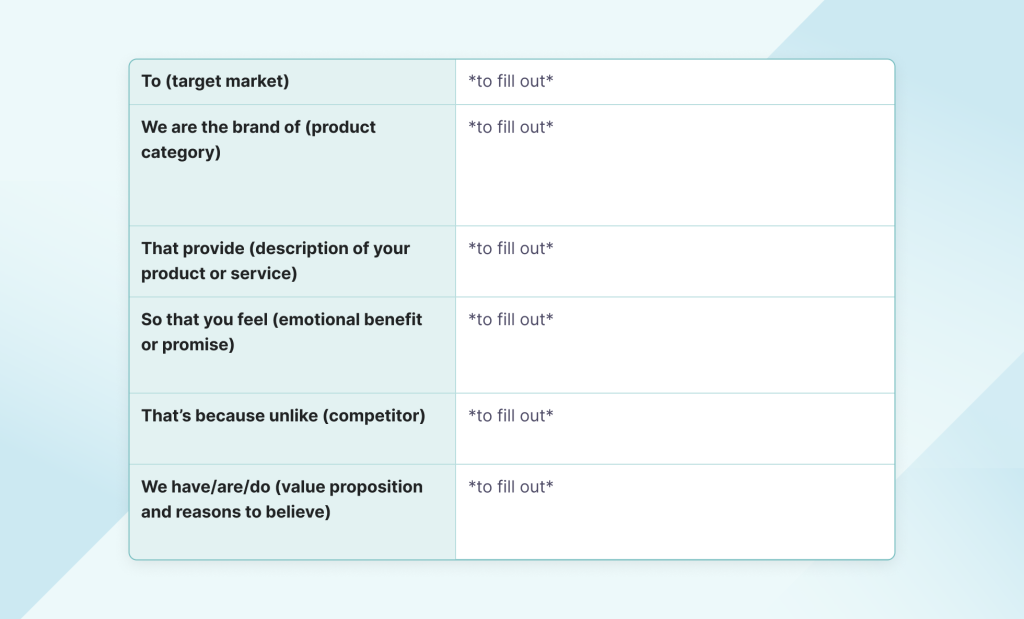
There are numerous positioning statement examples out there, just a Google search away. But what makes a good positioning statement? And what is the process behind creating a positioning statement?
Imagine you’re in the market for a contact management system and come across two CRM tools with two different positioning statements. One website says, “We provide contact management software.” The other confidently declares, “AI + Data + CRM. It all adds up to customer magic.” (And yes, this is from the Salesforce website.)
Which one of the two captures your attention more? The answer lies in the power of a well-crafted positioning statement. While these two are not positioning statement examples per se, each is a by-product of a positioning statement and its narrative.
💡A positioning statement plays a vital role in shaping the perception of your SaaS brand. It encapsulates your unique value proposition and communicates how your offering fits within the industry’s competitive landscape.
This blog post will describe our process for developing a positioning statement. Then we’ll wrap it up with 10 positioning statement examples from powerful SaaS companies that we think capture their value to their target audience effectively.
What is a positioning statement?
A positioning statement is a succinct declaration that conveys the distinctiveness and value of a product or service within its competitive market. It defines:
- The target audience
- The problem you solve or the need you fulfill
- The unique benefits you offer.
This statement forms the basis of your marketing and messaging efforts and will help you differentiate your products and services in a way that resonates with your ideal customers. It acts as a compass and will be the main driver behind all your marketing and communication efforts.
While there are many positioning statement examples out there, the process of getting to that final result can be quite different for each company.
Where can positioning statements be used?
- Variations of your positioning statement can be used in marketing communication activities directed toward customers, partners, investors, and other stakeholders. They create awareness, build brand perception, and drive engagement.
- However, they can also have internal applications. They can help align your employees around the company’s value proposition and guide your decision-making processes.
Positioning statement vs. value proposition
Below you will find a brief comparison of the differences between a value proposition and a positioning statement:
- The value proposition focuses on the unique benefits that distinguish a product or service from competitors, emphasizing the specific advantages that make a product or service appealing to customers. It addresses the “what” and “why” behind choosing a particular offering over the alternatives.
- The positioning statement takes it further by placing the brand within the broader context of the industry category. It takes the value proposition and expands it to show how the brand fits into its industry.
By crafting its own positioning statement, a company better understands where it stands in the market. It identifies its competitive advantage and how it differentiates itself from others in the same industry. This knowledge is crucial to shaping the brand’s identity and marketing efforts.
To create a well-rounded positioning statement, companies also need to look at other positioning statement examples from the industry to understand how competitors approach this task.
📣 A positioning statement provides a solid foundation for consistent messaging across various channels and ensures that the brand’s voice and value are communicated consistently to the target audience.
How we developed our positioning statement
We were lucky enough to start developing our product positioning in tandem with developing the Textmagic product itself. That’s really the ideal situation. However, even businesses with established products can reap the benefits of going through the motions of creating a positioning statement. They can use it to calibrate their offerings to market realities.
Developing a positioning statement for your product might seem like a pretty straightforward process:
- Identify the right audience
- Perform a competitive analysis
- Establish key differentiators
- Summarize everything in a 50-word statement.
As we learned, however, the reality is a whole lot different.
Did we rely on tried-and-true methods? Yes. Did we also improvise and adapt along the way? You bet. Have we found our true positioning statement for Textmagic? Well… maybe. We’ve come a long way since our early days of developing the Textmagic product. We would like to share some of what we’ve learned with you.
Let’s dive in and look at the path we followed and the positioning statement examples we analyzed along the way.
1. We defined our target audience and pain points
Every product positioning guide will tell you the first step is identifying your target audience and their pain points. And that’s precisely what you should do. If you don’t know who you’re selling to or if there is a need for your product or service, you’re walking blindfolded into unknown territory.
We started out as a business texting solution but knew we wanted to develop into business communication platform that offered a suite of messaging products for sales, marketing, and customer support in one neat package. Think Twillio or Hubspot, but more straightforward. But who would be our audience? And what pain points would our product solve?
Through conceptual research (basically scouring Google for every piece of relevant information) and empirical research (customer interviews), we identified our buyer personas and started building their profiles. We looked at their challenges, goals, and motivation.
That helped us define our target audience and gave us an idea about what category of consumers will most likely want (or need) our product. Here’s an example of one of our buyer personas and how we approached their profile:

Since Textmagic is a B2B product, we also looked at segmenting the types of businesses that would most likely benefit from our product. We categorized them according to their contact database size, number of employees, industries, etc.
Looking at the size of the business, for example, we found that, in our case, SMBs are a good market fit. That is because Textmagic is a budget-friendly yet effective alternative to most customer engagement tools with similar features and functionalities.

2. We identified the positive outcomes for the customers
After identifying our target audience and their pain points, we worked to discover the positive outcomes our product would bring to these consumers.
In our case, somewhat counterintuitively, we started with a problem statement: “The average company with 200 to 500 employees uses about 120+ SaaS applications these days.” That’s an issue because these applications are costly, bulky, and a pain to integrate and maintain. And from what we’ve seen, they end up being largely unused.
We asked ourselves, how can Textmagic help businesses be more cost-effective without sacrificing performance? We had the answer: by unifying sales, marketing, and customer support tools into one simple platform that is easy to use, easy to onboard, and most importantly, easy to scale budget-wise.
3. We researched competitive alternatives
3.1. Why is competitive analysis important?
Competitive analysis is crucial for any business because it provides valuable insights into the market landscape. This enables you to make informed decisions and gain a competitive edge. You can identify potential gaps in the market by thoroughly evaluating competitors’ products, pricing, features, marketing strategies, and customer feedback.
This analysis helps you understand customer expectations, position the product effectively within the competitive landscape, and identify your key differentiators. It also allows you to assess your strengths and weaknesses relative to competitors, enabling you to refine your product, pricing, and marketing strategies.
3.2. Competitive analysis applied to Textmagic
In Textmagic’s case, we were aware of having to launch a product in a market where our competitors were well-established companies like Hubspot, Zoho, etc. We’re not afraid to admit we were a little intimidated. But knowledge is power, and the more you know, the better.
🎓 Our research uncovered that some tools generally start at a lower price point than others. However, the pricing structures of both platforms are based on the number of contacts and we discovered usage-based pricing as a competitive advantage for our target audience.
Based on this information, we conducted a deeper investigation into pricing models. We discovered that a model based on the number of contacts could lead to a right-sizing problem, where businesses end up paying more for resources they don’t actually need.
That realization helped us decide to do things differently. Instead of a pricing model based on the number of agents, we opted for a pay-per-usage model where companies only pay for what they actually use. This allows cost conscious organizations to align costs closely with resource needs and scale their customer support operations more efficiently.
And that brings us to one of our key differentiators.
4. We identified our key differentiators
Identifying key product differentiators is essential: it clarifies what sets your offering apart from competitors. These differentiators are your product’s unique aspects, features, or benefits that make it superior or more appealing to customers.
By understanding and emphasizing your key product differentiators, you can position your brand effectively and communicate your value proposition to target customers. Articulating product differentiators also helps guide your product development and marketing strategies.
Looking at the Textmagic product and comparing it to other players in the market, we concluded that we were differentiated in three significant ways:
- Textmagic is really easy to use, literally plug-and-play
- The platform doesn’t require any technical setup
- Our pricing model is pay-per-use – one of the most cost-effective pricing models out there
Once we understood our key differentiators, creating our positioning statement was just a matter of good wordsmithing (or so we thought).
5. We created our product positioning statement
You can use your product positioning statement as is or elaborate and expand it to create relevant website content, other marketing collateral, sales collateral, and so on. Either way, the positioning statement sets the tone and keeps all your marketing and promotional communications in sync – the way a conductor leads an orchestra.
Suppose you’ve done your due diligence and followed the steps outlined above. In that case, you only need to organize this information into a central document, then distill it down to create a succinct positioning statement.
We found the value proposition canvas from Strategyzer extremely useful in this exercise, making good use of all the data and research we’ve been collecting.
The canvas helped us visualize our target customers’ needs, desires, and pain points, as well as the unique value our product offers to address those needs, resulting in a compelling (albeit temporary) positioning statement.
Here is an example of a positioning statement we created in the early days of Textmagic:
“For businesses that need to engage with their customers across all channels, Textmagic is the all-in-one no-code platform that delivers performance at a fair price. Unlike other business communication platforms, Textmagic is a lightweight, simple, and easy-to-use solution that doesn’t require a complex technical setup.”
While we were quite happy with it for the moment, it was not final or perfect by any means. And neither should yours be. Because, like us, you will probably be re-evaluating it at key times and adjusting as you go.
6. We double-checked our positioning statement for clarity
Running customer surveys or conducting internal reviews ensures that your positioning statement is easily understandable and resonates with your target market.
You can utilize several valuable tools and approaches to double-check the clarity and credibility of your positioning statement. A tool we found very useful is Wynter, a platform for testing and validating messaging with real customers.
We also conducted customer interviews, allowing us to engage directly with our target audience—those validated whether our initial positioning statement accurately reflected their needs and expectations.
During these interviews, we discovered that people have a very different understanding of business communication and customer engagement platforms. So, being precise and intentional in the language we used to position ourselves became even more important than anticipated.
Furthermore, when we involved internal teams like marketing and product development, they also provided a valuable perspective. We sought input from different teams to ensure the positioning statement aligned with the company’s strategy and capabilities.
🚀 By combining these tools and approaches, you can thoroughly evaluate your positioning statement, make necessary adjustments, and confidently communicate your product’s value proposition to your target audience.
7. We continuously improved our positioning statement
Continuously improving your positioning statement is crucial to ensuring its relevance and effectiveness. This is especially true since development scope, customer preferences, market dynamics, and competitive landscapes can change.
And that’s what happened to our positioning. We are moving from our initial “all-in-one customer engagement platform” positioning to focusing on providing an out-of-the-box business communication platform.
We decided to narrow the product development scope in the initial go-to-market (GTM) phase to better manage customer expectations and focus on one product at a time. However, we’re still considering the big picture — the “all-in-one customer engagement platform” will happen, just not as soon as we would have hoped.
To reflect the new direction, we amended our positioning statement as follows:
“For SMBs looking to improve inbound and outbound communication, Textmagic is the budget-friendly alternative that will empower their teams to solve customer queries faster and more efficiently with a lightweight, simple, AI-powered platform that is built for growth.”
To create these positioning statements, we used different templates, such as the ones provided by April Dunford or Userpilot. This offered us a structured framework and guided our positioning process. Applying this “method to the madness” helped us systematically assess and refine our:
- Value proposition
- Target audience
- Key messaging
Alternatively, you can create a customized template that aligns with your business and industry. The key is to regularly review your positioning statement to ensure it remains compelling, relevant, and impactful. This is another example of an easy-to-use template that you can copy and adjust to your own needs:

10 brilliant SaaS positioning statement examples
Check out our selection of the best real-life positioning statement examples.
1. HubSpot
“Since 2006, HubSpot has been on a mission to make the world more inbound. Today, over 100,000 total customers in more than 100 countries use HubSpot’s award-winning software, services and support to transform the way they attract, engage and delight customers. Comprised of HubSpot’s CRM, Marketing Hub, Sales Hub, and Service Hub, HubSpot gives companies the tools they need to Grow Better.”
Why we like it
Overall, HubSpot’s positioning statement effectively communicates its mission. It showcases its global reach and customer base, highlighting the value they provide through its suite of software and services.
What we appreciate about HubSpot’s positioning statement is its emphasis on helping companies “grow better.” This succinct phrase encapsulates their dedication to empowering businesses to achieve growth and success through comprehensive solutions.
Moreover, let’s not forget that back in 2006, HubSpot started as an internet marketing software that eventually evolved into one of the most popular inbound marketing solutions. It now boasts a full product suite of sales, CRM, customer service, and CMS tools. HubSpot has thus addressed the evolving needs of businesses while solidifying its market position.
2. Wistia
“We’re Wistia. We make marketing software, video series, and educational content based on the belief that anyone can use video to grow their business and their brand.”
Why we like it
We appreciate Wistia’s positioning statement because it encapsulates its passion for video marketing and dedication to empowering users. By inspiring confidence in the accessibility and effectiveness of video marketing, Wistia positions itself as a trusted partner for businesses seeking to unlock the benefits of this dynamic medium.
3. Slack
“Slack is the collaboration hub that brings the right people, information, and tools together to get work done. From Fortune 100 companies to corner markets, millions of people around the world use Slack to connect their teams, unify their systems, and drive their business forward.”
Why we like it
This positioning statement example from Slack effectively captures what the platform offers: being the ultimate collaboration hub. Slack highlights its role in facilitating effective teamwork and productivity. It does that by emphasizing the importance of bringing together the right people, information, and tools.
Whether it’s a Fortune 100 company or a small startup, Slack’s widespread adoption by millions of people worldwide speaks to its versatility and appeal across industries and organizations of all sizes.
4. Airbnb
“For local and international travelers, Airbnb is the only booking website that connects you to unique experiences worldwide because we offer the largest selection, most diverse, top-rated and personalized places to stay.”
Why we like it
By targeting this differentiated niche and segment, Airbnb has become synonymous with unique travel experiences. Their focus on offering the most extensive selection, diverse accommodations, and personalized stays has enabled them to capture travelers’ loyalty worldwide.
5. Amazon
“For consumers who want to purchase a wide range of products online with quick delivery, Amazon provides a one-stop online shopping site. Amazon sets itself apart from other online retailers with its customer obsession, passion for innovation, and commitment to operational excellence.”
Why we like it
Amazon’s positioning statement gets straight to the point without any ambiguity. It effectively communicates with Amazon’s target audience – online shoppers. It highlights the key reasons customers should choose Amazon:
- Its reputation for fast delivery
- Extensive product selection
- The convenience of being a one-stop shopping destination.
What truly sets Amazon apart is its unwavering dedication to innovation, operational excellence, and what they refer to as “customer obsession.” This commitment to constantly pushing boundaries and exceeding customer expectations is a distinguishing factor that differentiates Amazon from its competitors.
6. RingCentral
“RingCentral is a leading provider of cloud Message Video Phone™, customer engagement and contact center solutions for businesses worldwide. More flexible and cost-effective than legacy on-premise PBX and video conferencing systems that it replaces, RingCentral empowers modern mobile and distributed workforces to communicate, collaborate, and connect via any mode, any device, and any location.”
Why we like it
One key aspect that sets RingCentral apart is its cloud-based solution. It enables users to access their tool from anywhere, using any device. The convenience and accessibility that their platform offers differentiates it from technologies that are not cloud-based.
By clearly defining their differentiating factors, RingCentral showcases the advantages of its software and addresses common pain points experienced by businesses. Their positioning statement resonates with customers who seek a flexible, cost-effective, and easily accessible communications solution.
7. Alexa.com
“Alexa.com is a trusted source of insights into digital behavior that marketers use to help win their audience and accelerate growth. Subscribers to the Alexa Marketing Stack leverage rich competitor and audience insights that help them better understand their audience, discover opportunities for growth across multiple marketing channels, and manage the day-to-day workflows of planning, creating, optimizing, promoting, and measuring the effectiveness of their content marketing.”
Why we like it
Alexa.com’s positioning statement effectively communicates its role as a valuable tool for marketers seeking to win their audience and drive growth. It emphasizes its expertise in digital behavior analysis and showcases the range of benefits subscribers can access. This positions Alexa.com as a trusted ally in achieving marketing success.
8. Mailchimp
“Mailchimp is an all-in-one Marketing Platform for small businesses. We empower millions of customers around the world to start and grow their businesses with our smart marketing technology, award-winning support, and inspiring content.”
Why we like it
By positioning itself as a comprehensive solution, Mailchimp addresses the needs of entrepreneurs and business owners looking for a single platform to manage their marketing efforts. This meets the needs of the target audience. How? By having all marketing tools and resources in one place, which provides convenience and efficiency.
9. Dropbox
“Most productivity tools get in your way. They constantly ping, distract, and disrupt your team’s flow, so you spend your days switching between apps and tracking down feedback. It’s busy work, not the meaningful stuff. We want to change this. We believe there’s a more enlightened way to work. Dropbox helps people be organized, stay focused, and get in sync with their teams.’’
Why we like it
This positioning approach resonates with individuals and teams who strive for a more efficient and productive work environment. By addressing their pain points and offering a solution-oriented message, Dropbox successfully positions itself as a transformative tool for optimizing productivity and teamwork.
10. Shopify
“Make Commerce Better for Everyone. We believe that commerce is a force for good. By breaking down the barriers to building a business, we aim to empower more communities around the world to contribute to the global economy.’’
Why we like it
Shopify’s positioning implies providing the necessary tools, resources, and support to overcome these barriers. They empower individuals to pursue their entrepreneurial dreams. By emphasizing the positive impact of commerce, Shopify positions itself as a platform with a social mission beyond enabling business transactions.
Frequently Asked Questions (FAQs)
The five core elements of a positioning statement are target audience, market category, customer paint point, the product’s or service benefit, and a clear differentiator. Together, they define how your brand uniquely solves a problem for a specific group of customers.
A positioning strategy is the plan a company uses to define how its product or brand should be perceived in the minds of its target audience. It focuses on highlighting unique value, differentiating from competitors, and aligning messaging with customer needs to create a strong market presence.
Start by identifying your audience, their pain points, and how your product solves them better than competitors. Use a simple format like: “For [target customer], [your product] is a [category] that [benefit], unlike [competitor].”
A positioning statement is typically 1–2 sentences long. It should be concise, specific, and internally focused, as it is meant to guide messaging, not act as a public tagline.
A positioning statement helps unify your marketing, sales, and product strategy. It’s a good way to ensure your team communicates a consistent value message and knows exactly who the offering is for.
Related articles
3 Easy Google Calendar SMS reminder automations with Textmagic and Zapier
Managing schedules has become effortless thanks to d...
4 Google Sheets SMS integrations with Textmagic and Zapier
Google Sheets is a free spreadsheet app that is part...
7 Rules to follow when sending birthday text messages to your customers and employees
Sending customers and employees a text on their birt...
ClickSend vs. Textmagic: Features, pricing, and key differences
Choosing the right business messaging platform can m...
How to deal with angry customers: 10 Strategies and scripts that work
An angry customer isn’t just a bad day. It’s a fork ...




